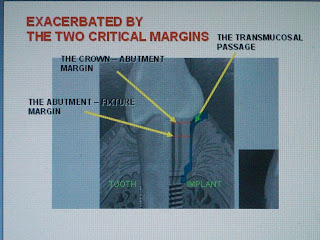Every dental implant ever placed has created an iatrogenic periodontal pocket. Yap! Has created a pathology in the mouth that has a certain amount of inflammatory infiltrate around it that ranges from a low grade perimucositis to a full fledged peri-implantitis.
This fact does militate against the use of large and extra-large diameter implants. The periodontal pocket that accompanies every dental implant we place is a reality that every implant dentist must accept and manage as an acceptable evil for the sake of the greater benefit of being able to replace a lost tooth almost as good as before.
The issue at hand is what is the best approach to managing this compromise for the sake of the larger good. The best replacement for a lost tooth of course is another tooth, and that will likely come in the future in the form of a tooth germ implant or stimulation of germ cells already present but dormant. As that may take another generation or so before we can bypass all the barriers involved, we are stuck with titanium screws for the forseable future with its accompanying perio pocket and the management issues involved.
 |
| KAI FOO'S THREE CRITICAL MARGINS |
The transmucosal passage of the dental implant is a poor imitation of that of the tooth. The tooth has a very sophisticated self-renewing living cuff around the neck of the tooth as it emerges into a bacteria filled environment.
There have been some claims of hemidesmosomes between the connective tissue and the surface of the implant but they are at best a far cry from the original ! Let us look at a study on the inflammation present around dental implants.
"PERSISTENT ACUTE INFLAMMATION AT THE IMPLANT-ABUTMENT INTERFACE"
is the title of this study. The conclusion suggests that, "these findings may motivate a clinician to place an implant shoulder above the alveolar crest or to utilize a one-piece implant to minimize potential inflammation and/or possible hard or soft-tissue loss".
I would like to further add that narrow diameter dental implants will give a smaller transmucosal passage and therefore arguably lower the amount of inflammation and therefore the chances of peri-implantitis in the long run, provided that satisfactorily hygienic prostheses( read the BUDDY SYSTEM in this blog) are delivered at the same time. This is assuming that narrow diameters are strong enough...... and time is beginning to indicate that it is, when used in the right way and context.
http://smalldentalimplants.blogspot.com/2010_05_01_archive.html
http://smalldentalimplants.blogspot.com/2010/05/buddy-system.html











No comments:
Post a Comment